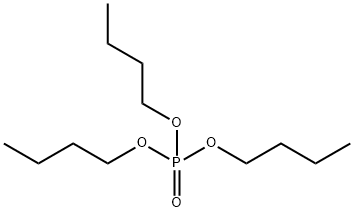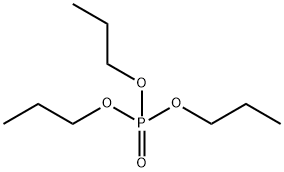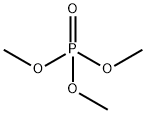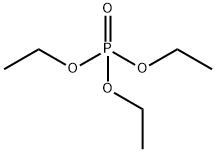PRODUCT Properties
| Melting point: | -79 °C (lit.) |
| Boiling point: | 180-183 °C/22 mmHg (lit.) |
| Density | 0.979 g/mL at 25 °C (lit.) |
| vapor density | 9.2 (vs air) |
| vapor pressure | 27 mm Hg ( 178 °C) |
| refractive index | n |
| Flash point: | 380 °F |
| storage temp. | Store below +30°C. |
| solubility | water: soluble1ml in 165ml water |
| form | Liquid |
| color | Clear |
| Odor | Odorless |
| Water Solubility | 0.6 g/100 mL |
| Merck | 14,9618 |
| BRN | 1710584 |
| Exposure limits | TLV-TWA 2.18 mg/m3 (0.2 ppm) (ACGIH), 5 mg/m3 (OSHA and NIOSH); IDLH 1300 mg/m3 (120 ppm) (NIOSH). |
| Dielectric constant | 6.5(20℃) |
| Stability: | Stable. Combustible. Incompatible with strong oxidizing agents. May be water sensitive. |
| LogP | 4 at 20℃ |
| Surface tension | 27.2mN/m at 298.15K |
| CAS DataBase Reference | 126-73-8(CAS DataBase Reference) |
| NIST Chemistry Reference | Tri-n-butylphosphate(126-73-8) |
| EPA Substance Registry System | Tributyl phosphate (126-73-8) |
Description and Uses
On decomposition, TBP releases COx, toxic fumes of phosphoric acid, phosphorus oxides, and/or phosphine. TBP is incompatible with strong oxidising agents and alkalis. The major uses of TBP in industry are as a component of aircraft hydraulic fluid and as a solvent for rare earth extraction and purification. Minor uses of TBP include use as a defoamer additive in cement casings for oil wells, an anti-air entrainment additive for coatings and floor finishes, as well as a carrier for fluorescent dyes. The major uses of TBP comprise over 80% of the volume produced.
Tributyl phosphate is used as a plasticizer for cellulose esters, vinyl resins, and lacquers; and in making fireretardants, biocides, defoamers, and catalysts.
Safety
| Symbol(GHS) |   GHS07,GHS08 |
| Signal word | Warning |
| Hazard statements | H302-H315-H351-H412 |
| Precautionary statements | P201-P202-P273-P301+P312-P302+P352-P308+P313 |
| Hazard Codes | Xn,F |
| Risk Statements | 22-38-40-62-48/20-36/37/38-11-20/22 |
| Safety Statements | 36/37-46-45-36/37/39-16-53 |
| OEB | B |
| OEL | TWA: 0.2 ppm (2.5 mg/m3) |
| RIDADR | UN 1208 3/PG 2 |
| WGK Germany | 2 |
| RTECS | TC7700000 |
| Autoignition Temperature | 770 °F |
| TSCA | Yes |
| HS Code | 29190010 |
| Hazardous Substances Data | 126-73-8(Hazardous Substances Data) |
| Toxicity | LD50 orally in rats: 3.0 g/kg (Smyth, Carpenter) |
| IDLA | 30 ppm |




